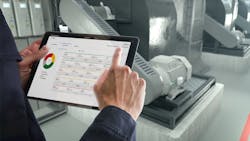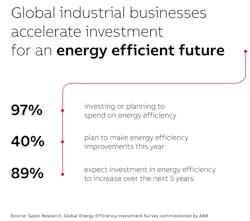Viewpoint by ABB’s Michael Plaster: Efficiency Business Keeps Getting Better
I recently hosted an EnergyTech webinar with our technology partners, Brainbox AI, in which we discussed several aspects of energy efficiency and renewables. Given that so much of almost any business’ overhead costs come from energy consumption, any efficiency gains will automatically produce some amount of cost savings. They often come from unexpected places.
Energy efficiency improvements also benefit the environment and help reduce emissions, particularly in the transportation sector. Following a UN report earlier this year calling for concerted action to cut greenhouse emissions at a faster rate, ABB commissioned an Energy Efficiency Investment Survey to gauge where industrial firms are with regard to efficiency improvements. The global survey, conducted by Sapio Research, targeted 2,294 companies in 13 countries, ranging in size from 500 to 5,000 or more employees, including 207 U.S. companies.
The results offer a clear picture that companies are investing in energy, not as a “greenwashing” exercise but because it’s what’s best for their business. On average, 23 percent of respondents’ annual operating costs are attributable to energy usage, which is seen as a legitimate threat to profitability. This is why an overwhelming majority of companies are investing in making their operations more energy efficient and indicate they will increase that investment over the next five years.
See the ABB Webinar free on demand: Register here
There is demand for products and services that can increase energy efficiency, but there is also a need to help business leaders better understand how energy efficiency benefits their business. The ABB/Sapio report revealed that only 41 percent of respondents felt they had all the information needed regarding energy efficiency measures. One way to address this is by taking a smaller, incremental approach (e.g., HVAC, lighting, remote monitoring) and working up to larger investments like electrifying their transportation fleet or overhauling motors and drives for manufacturing.
What’s holding efficiency back?
The ABB/Sapio survey identified multiple hurdles to increasing energy efficiency. By far, the most significant barrier to improving energy efficiency was cost, identified by 50 percent of respondents. Not surprisingly, cost was also by far the biggest barrier among those who have not and do not intend to invest in energy efficiency.
Saving energy means saving money, but cost is not the only hurdle that efficiency investments must overcome. Thirty-seven percent of respondents saw downtime as a barrier and more than two in five respondents from India, China, and Brazil mentioned workforce resistance to new technology as a significant hurdle.
This is not surprising since the introduction of new technology in the workforce has historically posed a threat to workers’ sense of security, stability, and purpose. Actively engaging workers during the pre-implementation phase may help companies lead from a position of empathy and develop buy-in among employees.
Despite the challenges, companies are investing in energy efficiency and renewable energy. Significant improvements are achievable today with existing technology and the application of data analytics is already improving on those gains. For energy-intensive industries like data centers, efficiency is already a working mantra, and it is likely to grow among other businesses as well in the coming years.
Transit offers a great example of how electrification can save energy and money. As far back as 2016, a Columbia University study of the New York City bus transit system found the City could save $160,000 per vehicle over the 12-year lifetime of the bus by switching from diesel to electric drive.
Buildings: Efficiency’s #1 target
The built environment offers a multitude of opportunities for property owners and tenants alike to reduce costs via greater energy efficiency, starting with the HVAC system. That’s where our partner, Brainbox AI has applied advanced analytics to the data building management and automation systems already collect. It doesn’t require a major capex outlay. Brainbox AI’s software rides on top of the existing building automation system. In a matter of weeks, it “learns” the topography of the building’s HVAC system and how the system is used, then makes recommendations to improve efficiency without sacrificing comfort.
Significant savings are thus well within reach for almost any commercial building. The key for building owners, perhaps, is to start with projects that will produce measurable savings reliably. Then, with a couple of wins under their belt, they can gain approval for more ambitious projects. If the company takes a long-term view, it becomes easier to justify energy efficiency investments within a lifecycle cost framework.
What do asset owners say?
ABB is investing in energy efficiency and renewables at our own facilities, and we’ve seen good results. For instance, at our factory in Senatobia, Mississippi, a 500kw solar power installation provides more than 30% of the site’s energy, and we have the space and plans to double that capacity. This $2 million investment enables ABB to reduce its demand from the grid, moves us closer to fulfilling our green energy initiatives, and helps us achieve a key ISO 50001 certification.
At another location, an upgrade to LED fixtures dramatically reduced the energy used for lighting, but it also yielded unexpected but measurable reductions in cooling load thanks to the elimination of the heat generated by conventional lights.
That is the win-win nature of energy efficiency, and the reason why it is so essential from both environmental and economic standpoints.
About the author: Michael Plaster has served as Lead Business Manager for ABB Electrification in the U.S. since 2020. He has been an executive leader with ABB for more than 17 years, including roles in Utility, Construction, and Industrial markets. He was appointed to the National Electrical Manufacturers Association (NEMA) Board of Governors in 2020. Mike has a Mechanical Engineering Technology degree from Purdue University and a Master’s in Business Administration from Butler University.
About the Author
Michael Plaster, Lead Business Manager, ABB Electrification U.S.
Michael Plaster has served as Lead Business Manager for ABB Electrification in the U.S. since 2020. He has been an executive leader with ABB for more than 17 years, including roles in Utility, Construction, and Industrial markets. He was appointed to the National Electrical Manufacturers Association (NEMA) Board of Governors in 2020. Mike has a Mechanical Engineering Technology degree from Purdue University and a Master’s in Business Administration from Butler University.


